Alan Cathcart | October 26, 2016
We give BMW’s new G 310 R a shakedown.
Sales of BMW motorcycles and scooters are riding at an all-time high, with 136,963 units delivered to customers around the world in 2015, 11% up on the previous year. In the first six months of 2016 the German manufacturer’s two-wheel division has delivered 80,754 machines, a further 3% up on the same period one year ago, as it ramps up annual sales to the 200,000 units by 2020 it’s set itself as a target.
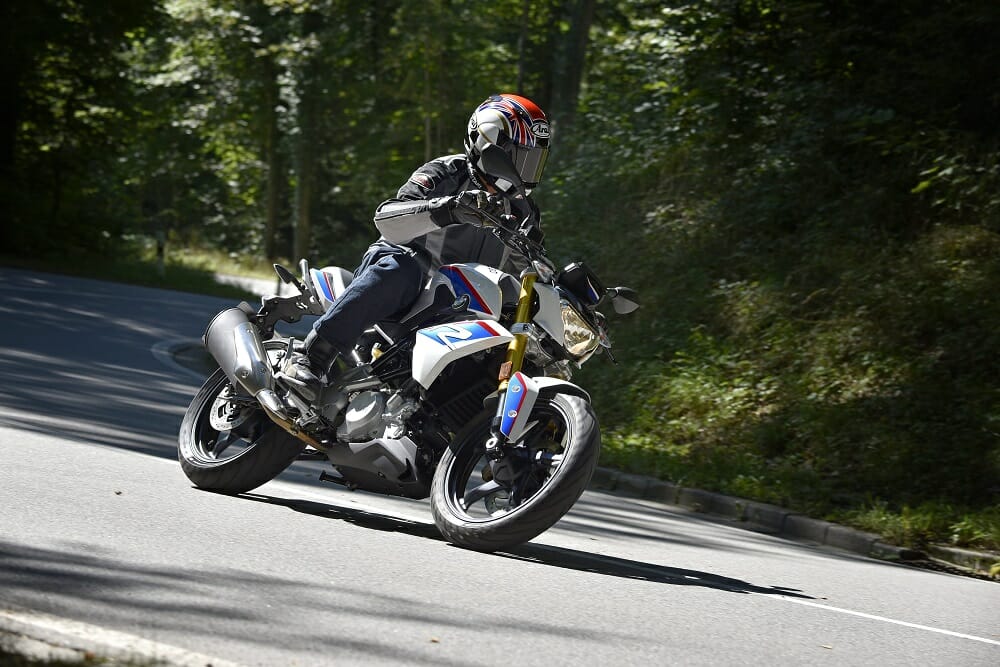 BMW hopes to attractive first-time buyers with its entry-level but still exciting G 310 R.
BMW hopes to attractive first-time buyers with its entry-level but still exciting G 310 R.
PHOTOGRAPHY BMW MOTORRAD
Key Ingredient
BMW hopes to drive ongoing increase in demand for its products via new platforms attracting first-time customers who may then progress up the ownership ladder in terms of price and capacity, and a key ingredient in that formula is BMW’s new G 310 R single. Designed and developed in Germany, but entirely manufactured in India by its partner TVS, BMW Motorrad presented this at the EICMA Milan Show in November 2015 as its debut model in the sub-500cc capacity segment. Production began in July at the TVS plant in Bangalore of a model that’s aimed as an entry-level bike in developed markets in Europe, Australia and Japan, and as a prestige model in developing markets such as Brazil and Southeast Asia. From 2017 onward the G 310 R will also be sold in the USA.
“Our key objective was very clear,” says Stoffregen of the G 310 R. “We wanted to produce a real grown-up motorcycle, not a toy, but a properly sized bike with all the attributes and appearance of a normal motorcycle, which can accommodate riders of all heights. It must also be built to a level of quality in keeping with the customer’s expectations from BMW in terms of styling, engineering, manufacturing quality and individuality. It was for us very important that this should be a true BMW, even though built in India by our partners TVS.”
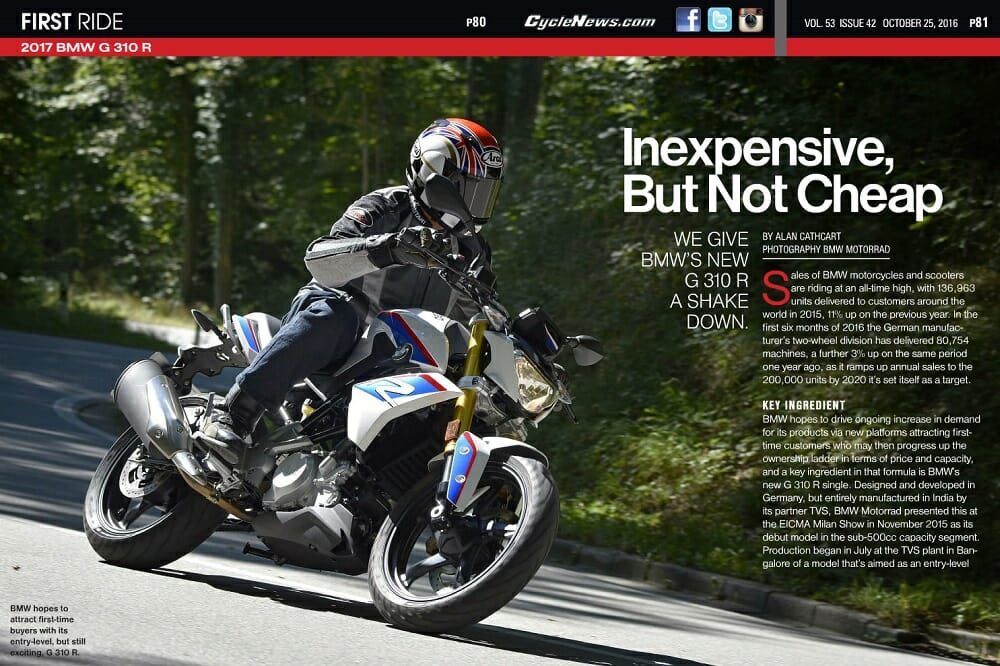
To read this in Cycle News Digital Edition, click HERE
Achieving an acceptable quality level for the finished product entailed a close collaboration with TVS, according to BMW Motorrad CEO Stephan Schaller. “We did the important part of the project in engineering and developing the bike in Germany to the stage that it was production ready,” he says. “But we also had many engineers from purchasing working with TVS in establishing a supply network in India to make sure that the standards of BMW are applied in sourcing components. TVS understands the BMW spirit.”
Why 300cc?
Owing nothing to any previous single in the company’s catalog such as the G 650 GS, this new Indian-made world bike is a clean-sheet design by BMW engineers in Munich. But why 300cc? “We wanted to have more than 250cc, because when we started, the Japanese firms in this segment like Kawasaki and Honda had a maximum capacity of 250cc,” says Stoffregen. “We decided that 300cc was likely to be the next step for them, so we decided to go with that capacity even though we had no competitor at that stage with such a model. I was quite pleased when Honda came out with the CBR300R!”
The G 310 R’s liquid-cooled Euro 4-compliant four-valve wet sump engine with chain-driven DOHC, six-speed gearbox, oil-bath clutch and a single gear-driven counterbalancer in front of the crankshaft, measures 80 x 62mm for a capacity of 313cc, and in aiming to offer compatibility with varying fuel qualities, has a relatively moderate 10.6:1 compression ratio. Carrying paired 33.5mm inlet valves and 27.2mm exhausts set at a flat total included angle of 24.5°, it delivers 34 bhp at 9500 rpm, with a 10,500 rpm limiter, maximum torque of 21 ft-lb at 7500 rpm, and a weight of 350 pounds fully loaded with 2.5 gallons of fuel—figure about 24 pounds more than a KTM 390 Duke. But unlike conventional single-cylinder engines, the G 310 R motor features a backwards-tilted cylinder, a format pioneered by Cannondale on its MX bikes 15 years ago, then copied by Yamaha on its 2010 YZ450F motocross bike, and now brought to the street for the first time here by BMW.
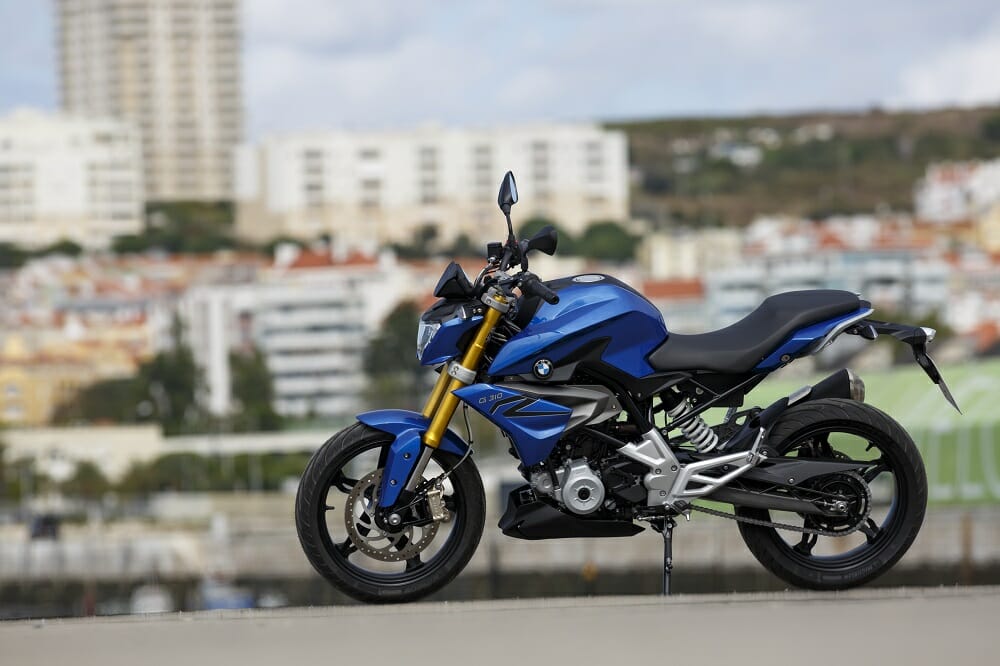 The 310 is built in India but under the watchful eyes of the boys in Munich.
The 310 is built in India but under the watchful eyes of the boys in Munich.
This sees the cylinder head, with its Nikasil bore, rotated by 180 degrees so that the 42mm throttle body faces forward for optimum ram air cylinder filling, as well as an advantageous layout to the bike with the exhaust running directly backwards. According to Jürgen Stoffregen, it was an architectural reason that drove this layout.
“We wanted to be able to have good stability and easy handling, but also extra weight on the front tire for increased safety in cornering via better grip,” Stoffregen says. “So for this reason we decided it would be good to position the engine a little bit forward, because then you can also make a longer swingarm which is good for stability. By rotating the cylinder head to allow you to do this you also have the spinoff bonus of a cooler, straighter charge going to the airbox. An extra benefit was that for Euro 4 you need a short length for the exhaust pipe, which this layout permits. It’s also nice for BMW to do something different when we are new to this sector, and can find a proper solution which is also individual.”
The G 310 R engine is thus positioned further forward than is conventional in its tubular steel chassis with a bolt-on subframe for the seat, a cast aluminum swingarm and 17-inch five-spoke cast aluminum wheels at each end, shod with Michelin rubber made in Thailand, the front a 110/70 tire, the rear a 150/60. This offers a 54-inch wheelbase, with a non-adjustable 41mm upside down fork sourced from Kayaba’s factory in China, set at a 25.1° rake with 4.7 inches of trail. This offers a rangy 5.5 inches of front wheel travel that’s welcome in coping with rough road surfaces, coupled with the 5.2 inches of wheel travel from the direct-action KYB cantilever rear monoshock, also non-adjustable.
The single 300mm front brake disc is gripped by a radially mounted four-piston ByBre (Brembo’s Indian subsidiary) caliper via steel hoses, with a floating twin-piston caliper grabbing the 240mm rear disc. Continental ABS is fitted as standard. The dual seat is stepped for the passenger, but even so there’s no room beneath it to house an anti-theft locking device of any kind.
The G 310 R’s only major components sourced from European suppliers are the F1-style finger-type cam-followers shared with the S 1000 RR (whose cylinder head design the G 310 R largely copies), the Magneti Marelli engine management system, and the two-channel ABS fitted as standard that’s supplied by Continental, who are also responsible for the very comprehensive LCD dash (including gear select!).
Finally, as with any BMW, there’s a range of accessories for the G 310 R, which includes a top box, center stand, LED indicators, a 12v socket and, of course, heated grips. There are also optional lower 29.9-inch or higher 32.1-inch variants to the relatively low stock seat height of 30.9 inches. All options must be installed by the dealer—the bikes are all in identical spec when shipped from India.
The 310 is available in three colors: blue, black and BMW’s trademark pearlescent Motorsport hue, which costs a little extra.
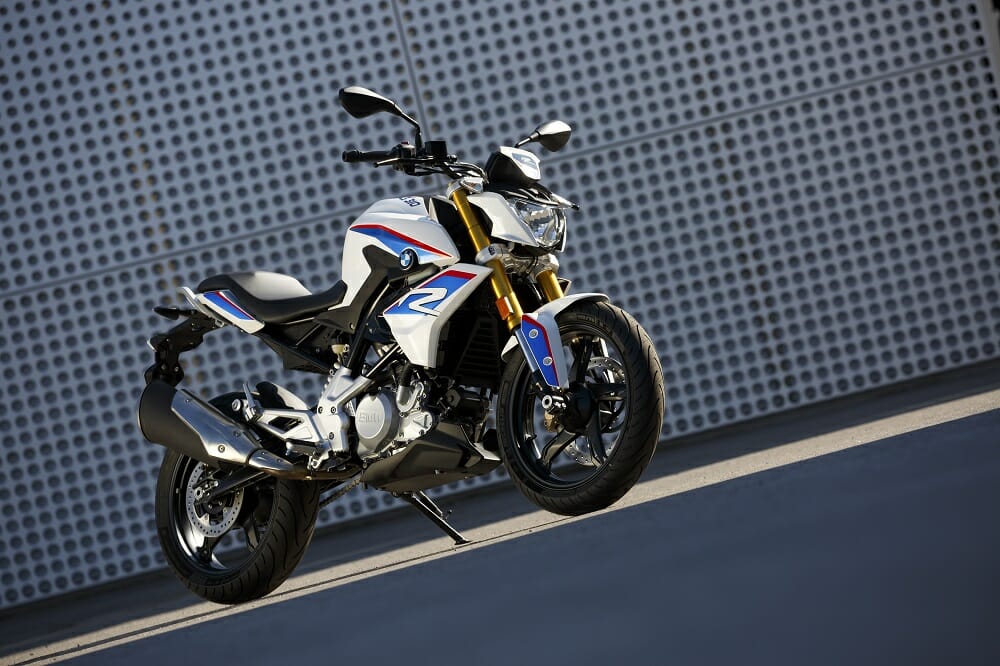 Hardly looks entry level, does it?
Hardly looks entry level, does it?
Time To ride
The invitation to join a select group of 30 journalists at BMW’s home city of Munich for an advance ride on the company’s Indian-made future bike delivered much more than just an hour or two of running around the streets of the city, with a brief venture out into the surrounding countryside. Instead, the 140-mile route took us south of Munich into the foothills of the Bavarian Alps, and comprised a broad range of riding conditions, including a brief spell of freeway travel when the homologated top speed of 89 mph showed up on the BMW’s digital Conti dash, with the tach just nudging the five-digit segment as the small shifter light started flashing. Yet at that engine speed, and all others, the 313cc single motor felt completely unstressed, and more to the point, totally vibe-free. The single counterbalancer does its job to perfection.
Just seeing the G 310 R awaiting me in the courtyard of BMW’s original 1922 factory that’s been redeveloped as its Group Classic HQ elicited a quite different reaction than seeing it indoors in a showroom or show. Especially in the Motosport livery, it has a real sense of substance, a classy sense of presence that conveys a different first impression than its brasher-looking European rival that’s also made in India, the lighter, bigger-engined and so slightly more powerful KTM 390 Duke. The BMW exudes a visual level of quality that’s frankly unexpected in such a low cost product manufactured offshore.
Only the plastic switchgear looks cut-price, the rest of the G 310 R components look very BMW, with high quality alloy castings and forged triple clamps, an LED tail light, an exceptionally lustrous paint job, and on this early production model at least, build quality looks good. This is an inexpensive BMW, not a cheap one.
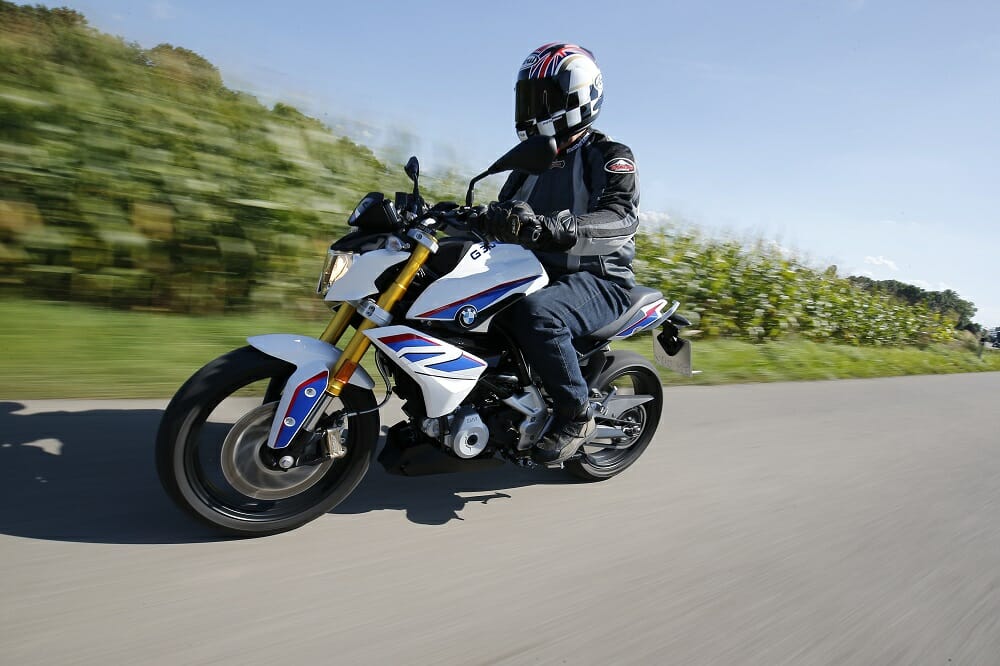 The 310 is designed to fit a wide range of shapes and sizes of riders.
The 310 is designed to fit a wide range of shapes and sizes of riders.
Those favorable first impressions extend to hopping aboard the relatively comfortable 31-inch high seat, and finding plenty of space for a 5’10” rider, with my knees tucked in nicely to the indentations in the plastic shroud housing the steel fuel tank beneath it. The seat still needs a little more padding just where it meets the tank to be properly comfortable in a full day’s ride, though.
Thumb the starter button, and the engine catches instantly from cold on the auto-choke, then settles to a quite high 1500 rpm idle, perhaps chosen to rule out any rear wheel chatter on the overrun in the absence of a slipper clutch. The large exhaust canister containing the Euro 4-compliant three-way catalyst whispers rather than booms, though above 5000 rpm there’s a pleasant rasp from the intake, which gives you the impression you’re going somewhere. As indeed you will be, by short-shifting through the six-speed gearbox which has a light, precise shift action and invites you to keep the engine on the boil via your left foot.
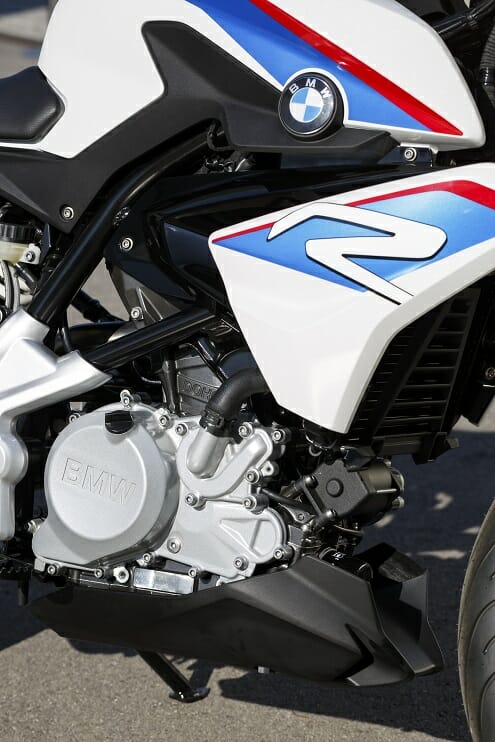 The 313cc single-cylinder motor delivers a wide spread of torque.
The 313cc single-cylinder motor delivers a wide spread of torque.
The oil-bath clutch action is light and untiring, making riding the BMW in city streets a pleasure; your hand won’t cramp up doing so, although bottom gear is very low, and obviously chosen for when a passenger is carried. You soon find it’s better to start from a stop on level ground in second gear if you’re on your own, without any need to slip the clutch unduly. But shifting gears is really a delight, and though you must use the clutch for the bottom two upward shifts to do so smoothly every time, you don’t need to do so in the higher ratios, and indeed so precise and clean is the shift action that you can drop from top gear to fifth without using the clutch, as well.
The G 310 R is indeed a great traffic tool, thanks also to the wide spread of torque peaking at 7500 revs, just three-quarters of the way to the 10,500 rpm rev limiter. The 310cc twin cam single pulls wide open in top gear from as low as 3200 rpm without any hesitation or transmission snatch, thanks to its good low-down fueling. Then there’s an extra kick of acceleration around 7000 rpm, and another one at nine grand, so it pays to rev it out. That’s not to say that the power delivery is layered, just that it becomes more urgent the harder you rev the motor. Nice. It’s also pretty economical, with a claimed consumption of 70 mpg.
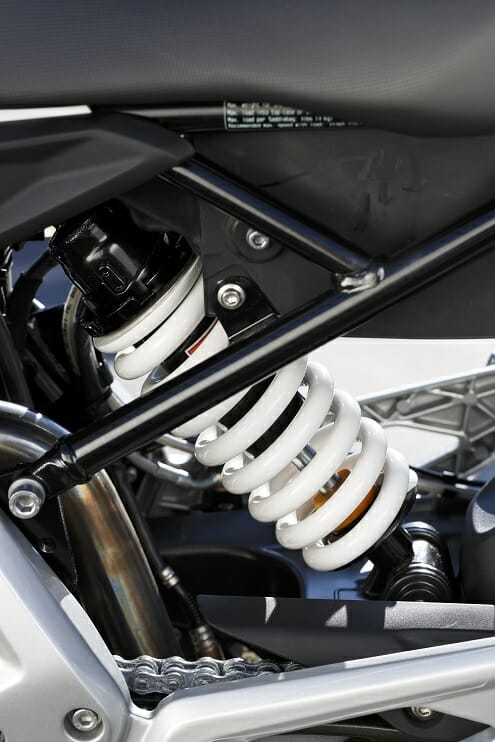 KYB is in charge of the 310’s suspension.
KYB is in charge of the 310’s suspension.
The G 310 R’s tubular steel frame more than lives up to the job of harnessing this power delivery well, and the non-adjustable KYB suspension plays a key role in this. Its fixed settings at both ends are extremely well chosen, with much better compliance than you have any right to expect for such budget hardware. Ride quality is high especially at the rear, and damping so well chosen that I ended up looking for the rare patches of rough tarmac on German B-roads to give it a workout. Compression damping on the fork could possibly be a little stiffer, because when you lean on the front brake for maximum stopping power there is some nose dive, but it’s not excessive. The single front 300mm disc and its four-piston radial caliper are just about up to the job of stopping the BMW and its solo rider hard from speed, but you must use the rear brake hard as well for panic stops, and you don’t get the feeling there’s much in reserve. It’s exactly the same brake package as on the KTM 390 Duke, where I think it works a little better. Pads, maybe?
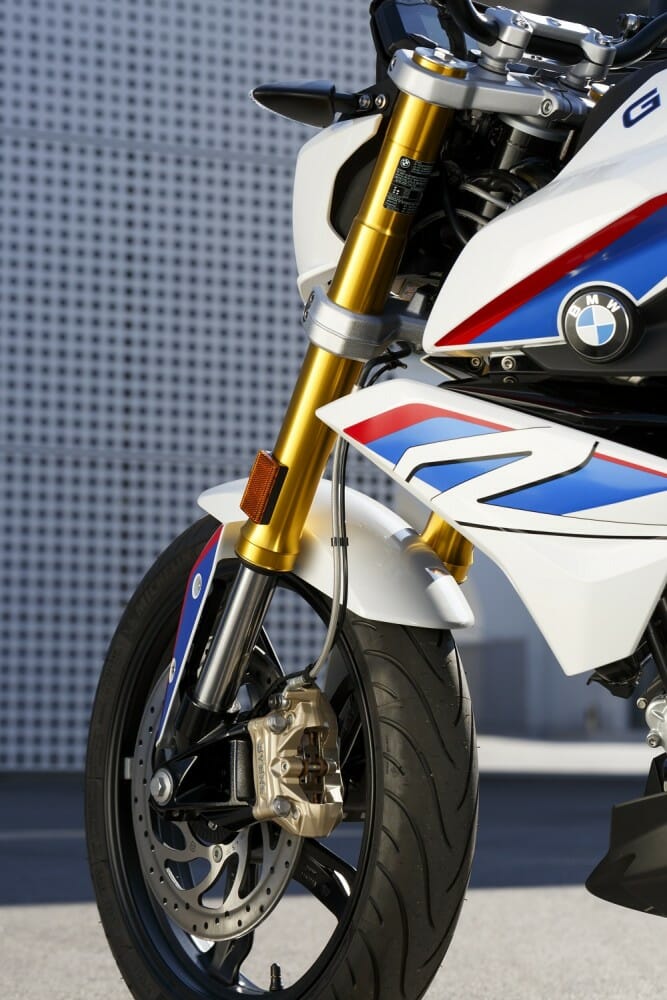 Like the shock, the 41mm KYB fork is non-adjustable, but BMW found a good setting for daily riding.
Like the shock, the 41mm KYB fork is non-adjustable, but BMW found a good setting for daily riding.
The BMW feels planted in a straight line. It gives no impression of being a schitzy lightweight package, in spite of which it changes direction very easily, aided by the good leverage from the black-painted handlebar whose grips are pulled back and slightly dropped. My only criticism is that there wasn’t much feedback from the front Michelin tire, which gripped okay at the speeds I was prepared to trust it at leaned over in turns, but seemed to have an unduly stiff structure for a small, lightweight bike like this. Apparently BMW has also homologated Metzeler tires for the G 310 R, and I’d like to try it again with these fitted. I suspect their lighter construction would deliver better feel, and thus increased turn speed from the KYB front end.
No doubt about it, BMW and TVS have joined forces to produce a motorcycle that’s self-evidently a BMW, but made in India largely to the standards of its Berlin factory. There’s an honest sense of manufacturing quality about the G 310 R, coupled with dynamic refinement in use. The engine is beautifully fueled, seems strong for its capacity level, and feels essentially unburstable.
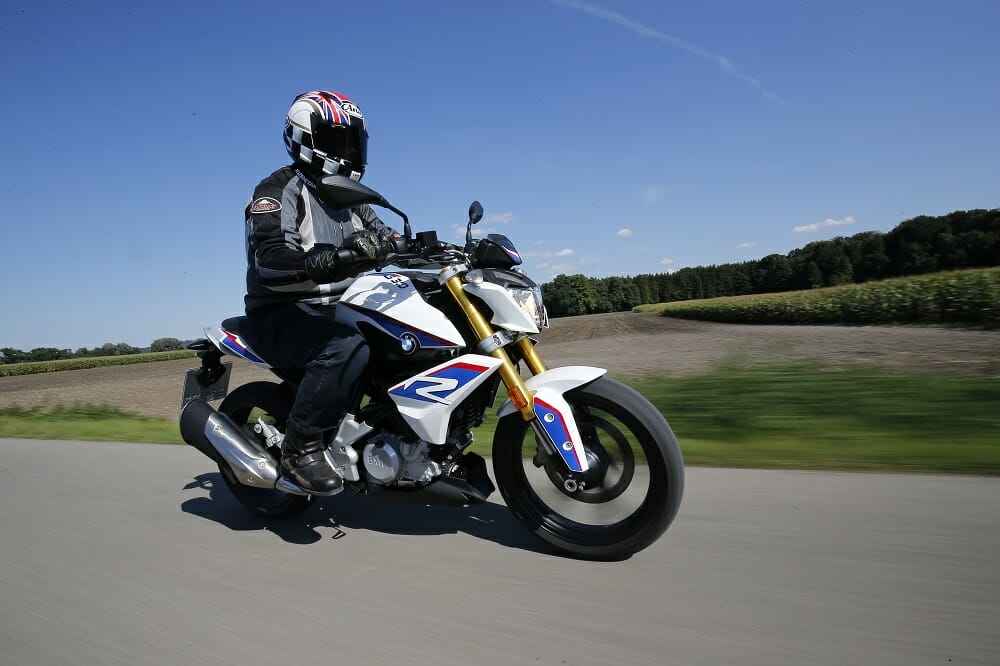 The 310 isn’t the cheapest bike in its class, but it’s not far off the mark. Luckily, a new rider won’t be in a hurry to upgrade with the 310—it’s that good.
The 310 isn’t the cheapest bike in its class, but it’s not far off the mark. Luckily, a new rider won’t be in a hurry to upgrade with the 310—it’s that good.
While keenly priced, it totally conforms to BMW’s brand identity in terms of performance, manufacturing quality, and styling. Its rivals such as KTM’s 390 Duke, Kawasaki’s Z300 Ninja, Honda’s CBR300R and Yamaha’s R3—oh, and not forgetting the excellent Chinese-made Benelli BN302, the sleeper of the class—have all got trouble on their hands, especially as BMW has strengthened its R&D back office via the recruitment of a pair of key KTM executives to lead the G 310 R development team. Andreas Wimmer was KTM’s project leader for all street singles, from the 125 Duke up to and including the 690 model range, and was responsible for working with Bajaj on the startup of KTM production in India. He’s been at BMW for the past two years, and has now been joined there by his former boss at KTM, Jӧrg Schüller, the Austrian firm’s former Product Manager. These guys are heavy hitters in product development, and the acquired knowledge they bring to the party of working with an Indian partner will be invaluable in developing the BMW-TVS partnership.
Because this is only the start—remember Schaller’s promise of additional models yet to come on this same 313cc platform. BMW is just getting started in the sub-500cc category. It’ll be very interesting to see how things move on from here. CN
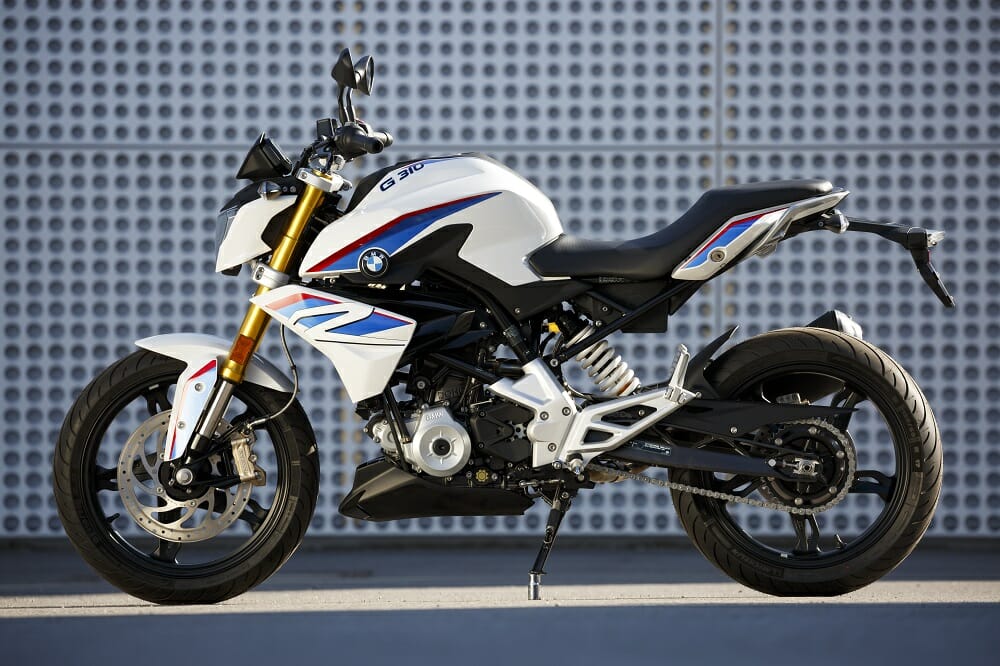
|
SPECIFICATIONS: 2017 BMW G 310 R
|
|
ENGINE TYPE:
|
Liquid-cooled, 4-valve, DOHC, single
|
|
DISPLACEMENT:
|
313cc
|
|
BORE/STROKE:
|
80 x 62mm
|
|
COMPRESSION RATIO:
|
10.6:1
|
|
ENGINE CONTROL:
|
BMS-E2
|
|
TRANSMISSION:
|
6-speed, constant mesh
|
|
CLUTCH:
|
Wet, multi-plate
|
|
DRIVE CHAIN:
|
O-ring chain
|
|
FRAME:
|
Tubular steel, bolt-on subframe
|
|
FRONT SUSPENSION:
|
41mm, Kayaba telescopic fork
|
|
REAR SUSPENSION:
|
Kayaba cantilever monoshock
|
|
FRONT WHEEL TRAVEL:
|
5.5 in.
|
|
REAR WHEEL TRAVEL:
|
5.1 in.
|
|
RAKE:
|
25.1°
|
|
TRAIL:
|
4.03 in.
|
|
WHEELBASE:
|
54.1 in.
|
|
FRONT BRAKE:
|
300mm single disc
|
|
REAR BRAKE:
|
240mm single disc
|
|
ABS:
|
BMW Motorrad ABS
|
|
WHEELS:
|
5-spoke, allow die-cast
|
|
FRONT TIRE:
|
110/70R 17 in.
|
|
REAR TIRE:
|
150/60R 17 in.
|
|
SEAT HEIGHT:
|
30.9 in.
|
|
CLAIMED WEIGHT:
|
349 lbs.
|
|
FUEL CAPACITY:
|
2.5 gal.
|
|
MSRP:
|
$5,790
|
To read this in Cycle News Digital Edition, click HERE
For more BMW motorcycle reviews, click HERE.
For more Cycle News Sport Bike motorcycle reviews, click HERE.